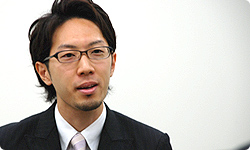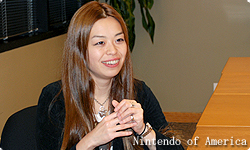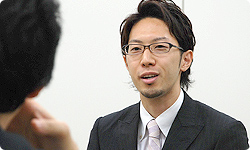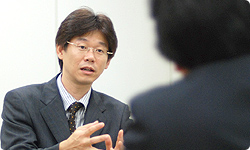3. Greedy Specifications
Ito-san, how did you become involved in this project?
They showed me the game part of the way through development and said they had to finish it in three months.
(laughs)
Nintendo presents: Style Boutique has Nintendo Wi-Fi Connection connectivity. Since this was something special that hadn’t been done before, bold changes needed to be made to the overall format. I think they called me in to help with that.
There is a good reason we called upon Ito-san. Hattori-san had come in almost as if to replace Tajima-san, but she said she was scared because she didn’t have any confidence when it came to clothes. I thought, “Hmm, I’ll have to find someone who looks like he’s got confidence when it comes to fashion…” and when I looked around, my eyes fell on Ito-san. He was in a different group, but I implored his manager to let us borrow him.
He knows a lot about Nintendo Wi-Fi Connection technical matters and is fashionable, so it was like killing two birds with one stone! (laughs)
He may be fashionable, but men’s and women’s fashions are quite different.
Just so there are no misunderstandings, I think you all may have overestimated me. I don’t know much about men’s fashion, and that’s even truer when it comes to women’s fashion! So when I joined the project, I ran out to a local newsagent and bought a carload of women’s fashion magazines. To broaden my horizons.
You must have looked pretty weird!
(laughs)
I was a little embarrassed. (laughs) But I figured my idea of fashion was probably biased, so I compared a wide variety of fashion magazines, asked my female colleagues their opinions, and cultivated in myself a sense of balance.

What did you think when you saw the software that had to be completed in three months?
My first impression was that all the materials were in place, but it was like a card game with no rules.
With 10,000 different cards. (laughs)
I thought that would bewilder the players. The game was about co-ordinating outfits, but the possible number of combinations was overwhelming.
Syn Sophia actually calculated the number of possible combinations of items. The result was over one septillion.
Septillion? That comes after trillion, quadrillion, quintillion and sextillion, right?
That’s 24 zeroes. An astounding number. (laughs)
Hattori-san had a perfect tutorial-like idea. It was to limit the number of items that can be used at first.
When Hattori-san told me that idea, I thought that if we did that, even I might be able to play the game!
Specifically, what kind of tutorial is it?
The players start as sales assistants learning at a shop called Primavera. Only an easy-to-grasp number of items are available, and you can start with instructions that even inexperienced persons can manage.
We went to syn Sophia and Hattori-san used a whiteboard to draw a flowchart explaining it.

They agreed and made a great prototype.
When I played that, for the first time I felt like it was a product I wanted to buy. I felt like I’d finally understood what it was Tajima-san had been saying was so fun all this time!
It took a year and a half for you to understand! (laughs)
If someone like me could enjoy it, then I was certain girls who like clothes would enjoy it. For someone like me, the Primavera stage takes a long time, but by the time it’s over, you know the rudiments of fashion, like how to co-ordinate colours and how different patterns go together. Once I’d learned the most basic of the basics, even I was able to pick out clothes.
Then you’re told you can have your own boutique, and you proudly become the boss.
But we weren’t done yet. If it was only about selling clothes and making an income, some people would get tired of it.
In order to have players return to it again and again, something else was needed.
So we included a number of events.
I thought if I really worked at a boutique and customers expressed their gratitude, I’d be really happy. For example, I’d like it if someone said, “I wore the clothes I bought here last week on a date, and my boyfriend complimented me. Thank you!”
So we made it so that similar events happen within the game. Sometimes a customer may invite you to go somewhere, and then you can go with her. On those occasions, you get to dress up yourself.

And you can take pictures while you’re out and save them. If you go to a concert, for example, you can decide on punk fashion. You change into the fashion that suits the situation and enjoy hitting the town! What’s more, you can design your own character. You can choose your hair length and colour, add highlights if you want, and even style it. And, of course, you can do your own make-up or change your eyebrows, etc. There are a lot of detailed settings.
Furthermore, there’s a fashion contest. If you win, you’ll be asked if you would like to reach for even greater heights. I think the fashion show has four levels…
No, there are more! (laughs) In addition to the fashion shows, you can accept interviews for magazines and spread your own trends. You can also participate in collaborations, and together with brand buyers create your own items by combining colours. A lot of special occasions arise.
Ito-san, your speciality is network technology. Were you able to do something new?
You can use Nintendo Wi-Fi Connection to set up your own store. Then, even when you’re not connected via Nintendo Wi-Fi Connection, others who are connected can see your boutique and make purchases from it.
You can dress up mannequins for display. When customers see them, they’ll come in.

In other words, there’s a virtual shopping mall with all the shops lined up in it. But suppose—and I’ll estimate high (laughs)—that we sell one million copies of the game and 400,000 shops open. It would be impossible to check them all!
With this software, the shops aren’t simply all lined up, but rather they’re bundled together into towns, and inside the towns there are buildings. Inside the buildings, there are separate floors. You can go shopping just like going to a regular shopping centre.
Is it up to chance where your shop appears?
Yes. But you don’t have to exchange Friend Codes2. If you know the town, building and floor name, you can go to a particular shop. That way you can tell your friends where your shop is via e-mails or notes, and they’ll show up ready to shop!
2 Friend Code: This is a code automatically generated when you use a particular game with Nintendo Wi-Fi Connection. If you pass it on to your friends, you can connect to and play together with them.
Also, information will spread by word of mouth—like “That shop has some cute outfits”—and you may get customers you don’t know!
You can also pass out flyers via Promo Mode3 and gain customers you don’t know that way as well. Also, you can always get your hands on items at bargain prices, so you should go around and try a lot of different shops. You’ll be able to enjoy seeing how everyone around the country dresses.
3 Promo Mode: A communications system that allows you to exchange data with other nearby Style Boutique players if you have the power of your Nintendo DS turned on.
Depending on how you proceed with the game, the items you can display in your store may change. You might go into the shop of someone you’ve never met and think, “Wow! She’s got such a wide selection of my favourite brand!”
Also, it follows the real calendar year, so the items you can stock change with the actual seasons.

You might recommend an item you like to a customer only to be told something like, “It’s too hot to wear a coat this season!”
Aside from Nintendo Wi-Fi Connection and chance connections, you can also connect wirelessly, so you can play shop or have contests with friends right in front of you.
That’s playing shop in a grand way! Did you put in everything you could think of?
Development was taking more time than I expected, so I wanted to do a thorough job. Before she left for America, Tajima-san checked with me to make sure we could put in everything she had thought of.
In other words, you were faced with greedy specifications right from the start. (laughs) Now I know why development took so much time!